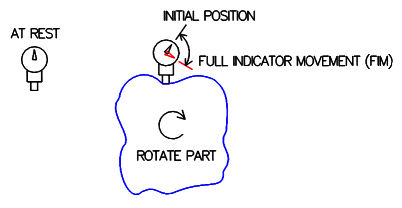An indicator is a device that measures the extension of a spring-loaded protrusion. An indicator can be placed against a workpiece to show cylindrical surface variation as the workpiece rotates. Full Indicator Movement (FIM) is the absolute difference between the minimum and maximum reading of an indicator as a workpiece is rotated a full revolution. FIM is used to establish whether a part meets its runout or total runout tolerance. When measuring a part, the indicator measurement device (shown in the left figure below) is placed on the part. Placing the device on the part displaces the indicator to its initial position (shown in the right figure). As the part is rotated, the indicator fluctuates between its min and max positions based on the highest and lowest points on the part. The absolute difference between the final min and max positions establishes the FIM of the part.
